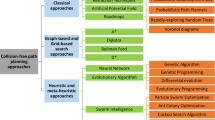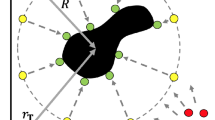Abstract
Formation control is a potential advanced technology for aircrafts, spacecrafts and space robots. This paper, for the first time, studies several methods of passive and semi-active Remote Center Compliance (RCC) in order to examine their effects on formation control of a group of Wheeled Mobile Robots (WMRs) for object manipulation during space/terrestrial explorations. To this end, first, the dynamics model of the constrained non-holonomic robots, object and RCC system have been derived precisely. A leader-follower control strategy is then utilized for trajectory tracking of the desired path by the cooperative robots. Finally, the passive and semi active RCC are optimized to make the formation robust in the presence of significant disturbances. The results obtained reveal that the semi-active RCC system, combined with a PID controller, reduces the effect of the disturbances experienced as compared to the other passive RCC modules.
Similar content being viewed by others
References
R. W. Beard, J. Lawton, and F. Y. Hadaegh, “A coordination architecture for spacecraft formation control,” IEEE Transactions on Control Systems Technology, vol. 9, no. 6, pp. 777–790, 2001. [click]
H. Choi, K. W. Yang, and E. Kim, “Simultaneous global localization and mapping,” IEEE/ASME Trans. on Mechatronics, vol. 19, no. 4, pp. 1160–1170, 2014. [click]
L. D. Baskar, B. De Schutter, and H. Hellendoorn, “Traffic management for automated highway systems using modelbased predictive control,” IEEE Trans. on Intelligent Transportation Systems, vol. 13, no. 2, pp. 838–847, 2012. [click]
H. Rezaee and F. Abdollahi, “A decentralized cooperative control scheme with obstacle avoidance for a team of mobile robots,” IEEE Trans. on Industrial Electronics, vol. 61, no. 1, pp. 347–354, 2014. [click]
P. De Cristoforis, S. Pedre, M. Nitsche, T. Fischer, F. Pessacg, and C. Di Pietro, “A behavior-based approach for educational robotics activities,” IEEE Trans. on Education, vol. 56, no. 1, pp. 61–66, 2013. [click]
D. Xu, X. Zhang, Z. Zhu, C. Chen, and P. Yang, “Behaviorbased formation control of swarm robot,” Mathematical Problems in Engineering, 2014.
J. L. Lin, K. S. Hwang, and Y. L. Wang, “A simple scheme for formation control based on weighted behavior learning,” IEEE Trans. on Neural Networks and Learning Systems, vol. 25, no. 6, pp. 1033–1044, 2014. [click]
J. Dong, H. T. Chen, and S. Liu, “A Behavior-based policy for multirobot formation control,” Applied Mechanics and Materials, vol. 220, pp. 1181–1185, 2012.
A. Abbaspour, S. A. A. Moosavian, and K. Alipour, “A virtual structure-based approach to formation control of cooperative wheeled mobile robots,” Matrix, vol. 2, p.2b.
Y. Abbasi, S. A. A. Moosavian, and A. B. Novinzadeh, “Formation control of aerial robots using virtual structure and new fuzzy-based self-tuning synchronization,” Trans. of the Institute of Measurement and Control, p.0142331216649021.
A. Hassani, F. Saghafi, and M. Pasand, “H∞ and μ synthesis control of virtual structure satellites formation flying,” International Journal of Dynamics and Control, pp. 1–15, 2016.
A. Abbaspour, S. A. A. Moosavian, and K. Alipour, “Formation control and obstacle avoidance of cooperative wheeled mobile robots,” International Journal of Robotics and Automation, vol. 30, no. 5, pp. 418–428, 2015.
H. Xia, T. Z. Huang, J. L. Shao, and J. Y. Yu, “Leaderfollowing formation control for second-order multi-agent systems with time-varying delays,” Trans. of the Institute of Measurement and Control, vol. 36, no. 5, pp. 627–636, 2014.
J. P. Desai, J. P. Ostrowski, and V. Kumar, “Modeling and control of formations of nonholonomic mobile robots,” IEEE Trans. on Robotics and Automation, vol. 17, no. 6, pp. 905–908, 2001. [click]
A. K. Das, R. Fierro, V. Kumar, J. P. Ostrowski, J. Spletzer, and C. J. Taylor, “A vision-based formation control framework,” IEEE Trans. on Robotics and Automation, vol. 18, no. 5, pp. 813–825, 2002. [click]
G. L. Mariottini, F. Morbidi, D. Prattichizzo, G. J. Pappas, and K. Daniilidis, “Leader-follower formations: uncalibrated vision-based localization and control,” Proc. of IEEE Robotics and Automation, pp. 2403–2408, 2007.
H. M. Wu, M. Karkoub, and C. L. Hwang, “Mixed fuzzy sliding-mode tracking with backstepping formation control for multi-nonholonomic mobile robots subject to uncertainties,” Journal of Intelligent & Robotic Systems, vol. 79, no. 1, pp. 73–86, 2015. [click]
D. Qian, S. Tong, J. Guo, and S. Lee, “Leader-followerbased formation control of nonholonomic mobile robots with mismatched uncertainties via integral sliding mode,” Systems and Control Engineering, vol. 229, no. 6, pp. 559–569, 2015.
T. L. De Fazio, D. S. Seltzer, and D. E. Whitney, “The instrumented remote centre compliance,” Industrial robot, vol. 11, no. 4, pp. 238–242, 1984.
J. J. Craig, Introduction to Robotics: Mechanics and Control, Upper Saddle River: Pearson Prentice Hall, 2005.
H. Du, K. Y. Sze, and J. Lam, “Semi-active H∞ control of vehicle suspension with magneto-rheological dampers,” Journal of Sound and Vibration, vol. 283, no. 3, pp. 981–996, 2005.
S. Ikenaga, F. L. Lewis, J. Campos and L. Davis, “Active suspension control of ground vehicle based on a fullvehicle model,” Proc. of American Control Conference, vol. 6, pp. 4019–4024, 2000. [click]
B. Creed, N. Kahawatte, and S. Varnhagen, “Design of an lqr control strategy for implementation on a vehicular active suspension system,” MAE, p.272.
S. A. A. Moosavian and E. Papadopoulos, “Cooperative object manipulation with contact impact using multiple impedance control,” International Journal of Control, Automation and Systems, vol. 8, no. 2, pp. 314–327, 2010. [click]
S. K. Saha and J. Angeles, “Dynamics of nonholonomic mechanical systems using a natural orthogonal complement,” Journal of Applied Mechanics, vol. 58, no. 1, pp. 238–243, 1991.
K. Maček, “Motion planning of mobile robots in indoor environments,” Doctoral dissertation, Fakultet elektrotehnike i računarstva, Sveučilište u Zagrebu.
S. A. A. Moosavian and R. Rastegari, “Multiple-arm space free-flying robots for manipulating objects with force tracking restrictions,” Robotics and Autonomous Systems, vol. 54, no. 10, pp. 779–788, 2006.
H. Li, W. Yan, and Y. Shi, “A receding horizon stabilization approach to constrained nonholonomic systems in power form,” Systems and Control Letters, vol. 99, pp. 47–56. [click]
H. Li, P. Xie, and W. Yan, “Receding horizon formation tracking control of constrained underactuated autonomous underwater vehicles,” IEEE Trans. on Industrial Electronics, 2016.
W. He, Y. Dong, and C. Sun, “Adaptive neural impedance control of a robotic manipulator with input saturation,” IEEE Trans. on Systems, Man, and Cybernetics: Systems, vol. 46, no. 3, pp. 334–344. [click]
W. He, Y. Ouyang, and J. Hong, “Vibration control of a flexible robotic manipulator in the presence of input deadzone,” IEEE Trans. on Industrial Informatics, vol. 13, no. 1, pp. 48–59, 2017. [click]
W. He, Y. Chen, and Z. Yin, “Adaptive neural network control of an uncertain robot with full-state constraints,” IEEE Trans. on Cybernetics, vol. 46, no. 3, pp. 620–629, 2016. [click]
W. He and Y. Dong, “Adaptive fuzzy neural network control for a constrained robot using impedance learning,” IEEE Trans. on Neural Networks and Learning Systems, 2017.
Author information
Authors and Affiliations
Corresponding author
Additional information
Recommended by Associate Editor Yangmin Li under the direction of Editor Hyun-Seok Yang. The authors would like to thank the financial support provided by Islamic Azad University, Qazvin Branch, for accomplishing this research.
Khalil Alipour received his B.S., M.S. and Ph.D. degrees all with honors in Mechanical Engineering from K. N. Toosi University of Technology, in 2002, 2004 and 2010, respectively. Currently, he is an Assistant Professor with the Faculty of New Sciences and Technologies at University of Tehran. He teaches courses in the areas of robotics, dynamics, automatic control, analysis and synthesis of mechanisms. His research interests are in the areas of dynamics modeling, automatic control, motion/path planning of robotic systems and tip-over stability analysis of mobile robots. He has published various articles in international peer reviewed journals and conference proceedings.
Adel Abbaspour received his B.S. and M.S. degrees in Mechanical Engineering from K. N. Toosi University of Technology, in 2009 and 2011, respectively. Currently, he is a designer of modern control systems in Iran’s industry. Meanwhile, he is research assistance at Advanced Robotics and Automated Systems Lab. (ARAS) at K. N. Toosi University of Technology. His research interests are in the areas of dynamics modeling, automatic control, motion/path planning of robotic systems and fault tolerant in formation of mobile base robots.
Rights and permissions
About this article
Cite this article
Alipour, K., Abbaspour, A. The Effect of Remote Center Compliance Parameters on Formation Control of Cooperative Wheeled Mobile Robots for Object Manipulation. Int. J. Control Autom. Syst. 16, 306–317 (2018). https://doi.org/10.1007/s12555-016-0604-7
Received:
Revised:
Accepted:
Published:
Issue Date:
DOI: https://doi.org/10.1007/s12555-016-0604-7




